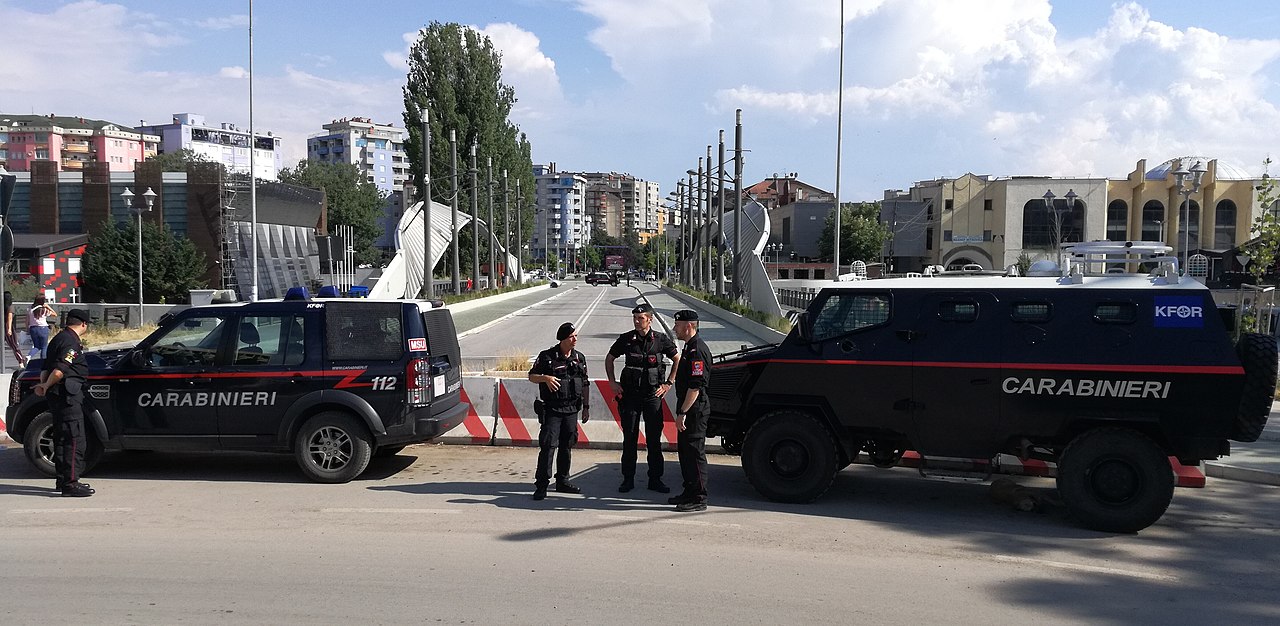Twenty-five years since the war ended and 15 years into the declaration of Kosovo’s independence, Kosovo’s Mitrovica has remained divided. The central bridge across the Ibar was supposed to connect the two parts of the city – Serbian and Albanian. The structure, which by its very definition should unite, has become a permanent source of controversy.
Impossible without consent from the Serbs…
The bridge in Mitrovica was supposed to be officially opened for traffic back in January 2017, but this never happened. The ceremony set to be attended by high-ranking EU officials was postponed several times before the topic gradually lost its relevance.
More than a year ago, the issue once again resurfaced.
In April 2023, the municipal assembly of North Mitrovica, which was left with virtually no Serbian representatives after the Serbs withdrew from all Kosovo institutions in November 2022, decided to finally launch traffic across the main bridge in Mitrovica. These plans sparked a rather sharp reaction from local Serbian leaders and high-ranking officials in Serbia, who noted that the purpose of the move was to provoke conflict and, ultimately, to expel Serbs from Kosovo.
Commenting on the decision of the North Mitrovica municipality to open the bridge over the Ibar, Serbian President Aleksandar Vučić said Kosovo Prime Minister Albin Kurti “seeks conflicts at any cost.”
EU officials then also criticized the initiative, noting that now is not a good time to open the main bridge in Mitrovica. The NATO mission, KFOR, emphasized the need for political dialogue to resolve the issue of opening the central bridge across the Ibar. Translated from diplomatic to normal language, these statements stressed that the bridge should be opened only after the Serbs agree to it.
The opening was postponed. But a few days ago, the topic became relevant, again.
In May, representatives from Albin Kurti’s party, Self-Determination Movement, at the municipal meeting in North Mitrovica appealed to implement the decision made last year regarding the opening of the bridge over the Ibar. At the same time, deputy director of the Kosovo police in the northern region, Veton Elshani, said that bridge over Ibar in Mitrovica would be open to traffic “very soon”. In an interview with Kosovo television, he noted he was currently discussing with his leadership the way this should be done. “I believe it’s only a matter of time when and how the bridge opens,” Elshani told reporters.
The negative reaction from the Serbs and international community to the renewed discussion of the bridge opening came almost immediately.
The leading Serb party in Kosovo, Serbian List, said opening the bridge to traffic was “an absolutely unnecessary, unacceptable, and escalating step aimed at further destabilization.” They called on the international community to “signal to Kurti that the opening of the bridge cannot be done without the consent from the Serbs living in the north of Kosovo”, and currently representatives from the Serb community are showing no support for such a move.
The European Union recalled that the issue of opening the bridge was part of the EU-mediated dialogue, and therefore all decisions should be made within the framework of that process, involving the official delegations from Kosovo and Serbia.
NATO’s mission in Kosovo, KFOR, has also, as always, called for any decisions on the main bridge over the Ibar to be made within the framework of the Kosovo-Serbia dialogue, mediated by the European Union.
It should be noted that currently there are no obstacles for those who really need to cross the Ibar. Traffic is active across other bridges available in the area. But the central bridge in Mitrovica has long ceased to be seen purely as an infrastructure element.
The story of the bridge
Immediately after the war, the famous bridge was assigned the role of a “peacemaker”. In 2001, the French government contributed nearly EUR 1.5 million to restoring the bridge. The work was supposed to be a step not only towards post-war reconstruction, but also towards reconciliation: the terms of the contract stipulated that a multi-ethnic construction crew consisting of both Albanians and Serbs should be involved. Despite all obstacles, all work has been done.
However, that peaceful idyll didn’t last long.
In March 2004, massive riots broke out in the north of Kosovo following reports that three Albanian children had drowned in the Ibar after being attacked by Serbs. The Serbian side denied any involvement, but the flywheel of violence had already gone loose. The next day after the tragedy, Albanians took to the streets on the southern bank. KFOR units blocked the bridge, but this failed to stop the fighting. Violence spread throughout Kosovo as 19 people – 11 Albanians and eight Serbs – were killed amid the riots.
Since that time, the bridge over the Ibar in Mitrovica has not functioned in full.
In the early 2010s, shortly after Kosovo declared independence, there came a new outbreak of violence, and once again the city of Mitrovica came into a spotlight.
In July 2011, Kosovo police secured control over checkpoints on the Kosovo-Serbia border in the north, which sparked protests from Serbs and led to clashes.
As tensions climaxed in the north, more than a dozen barricades were erected, including on the bridge over the Ibar.
Restoring the functioning of the bridge was among the issues discussed at the negotiations on the normalization between Belgrade and Pristina, launched under the auspices of the European Union a decade ago. The agreement on the normalization between Kosovo and Serbia provided for the “revitalization of the bridge”, which aimed to ultimately launch traffic across the river.
In 2014, the barricade on the bridge was finally dismantled, but the Serbs immediately replaced it with the so-called “Peace Park” – a few small trees in concrete pots.
The “park barricade” was dismantled in 2016 when the bridge went under reconstruction agreed as part of EU-mediated talks between Pristina and Belgrade.
As EU-funded repairs costing over EUR 1.2 million were completed, local Serb authorities started building a two-meter-high concrete wall on the north side of the bridge.
It was officially stated that it is a purely technical structure – a retaining wall for the embankment. Some time later, after intense talks, with the mediation of the EU, the parties managed to reach an agreement on removing the wall, which was done accordingly. But then the street that went from the northern part of the bridge was declared pedestrian, which complicated the effort to set up vehicle traffic…
A symbol… of what though?
The endless and tense history of the bridge in Kosovo’s Mitrovica shows that any peacemaking efforts made through symbolic moves have their limits. The creative idea by EU officials to transform the bridge into a symbol of positive change was confronted by no less creative opposition by the Serbs.
Now it is important for the Serbs to demonstrate that they are safe in Kosovo, and the bridge is supposed to play an important role to this end.
The promotion of the Serbian vision of the bridge situation led to the latter serving as a symbol of an unresolved conflict.
On the other hand, the latest initiatives by the Albanians to promote the idea of finally opening the bridge are aimed at implementing another symbolic act – fixating Pristina’s power in the north. An open bridge would be part of the process alongside the ban on the cash dinar and closure of Serbian banks in the north…
It is now clear that the “bridge issue” is in no way purely about ensuring proper logistics. This is a question of the struggle of different symbols and senses. And while the struggle continues, the dysfunctional bridge serves as a symbol of the impasse in which the dialogue between Belgrade and Pristina, brokered by Brussels, remains to this day.



